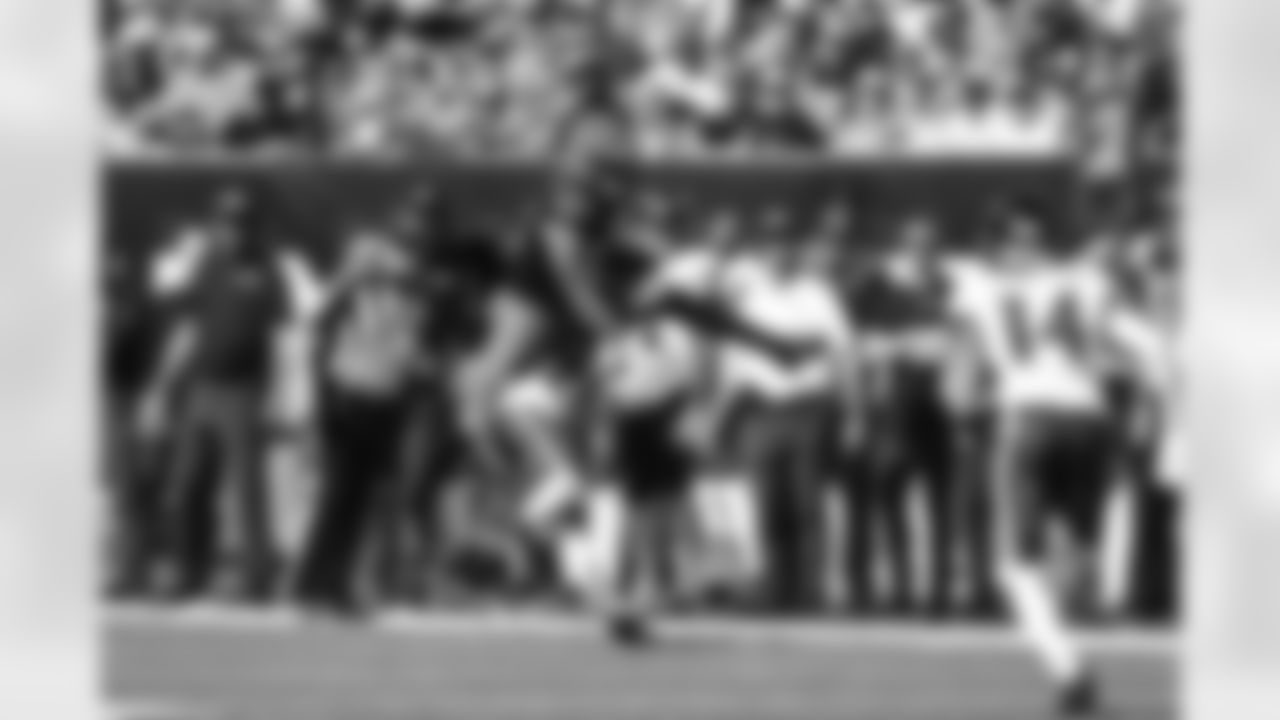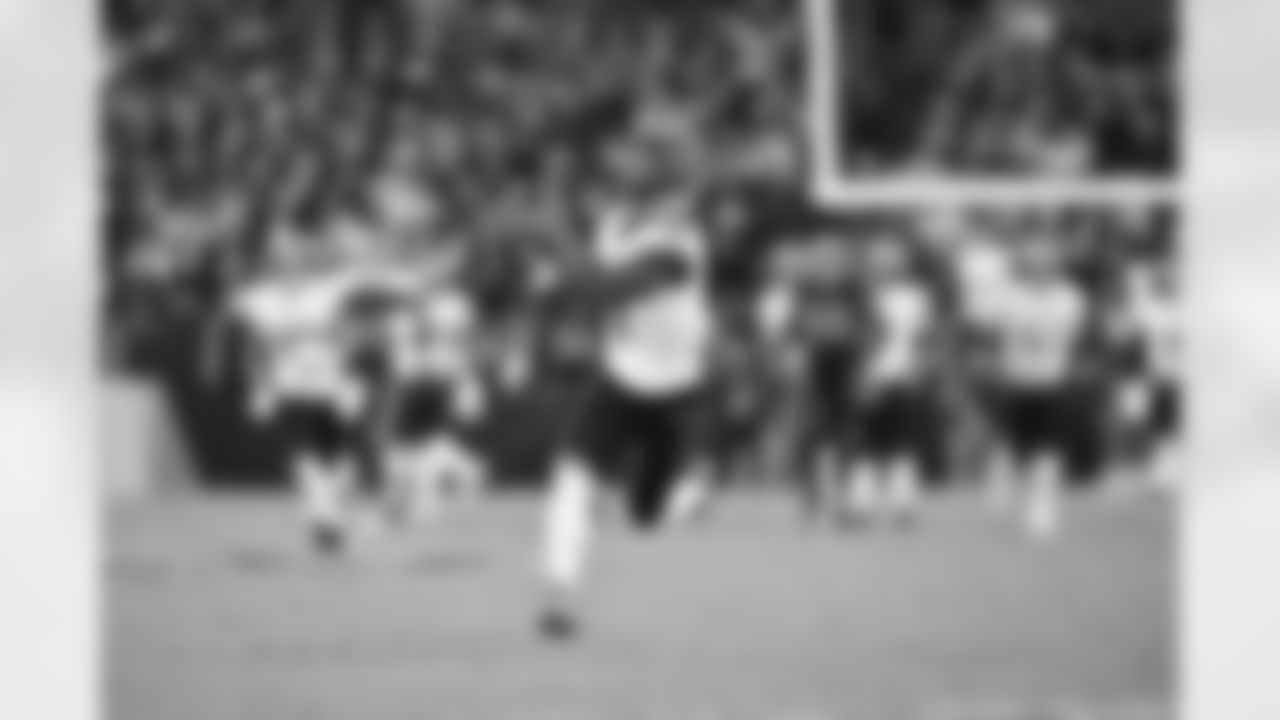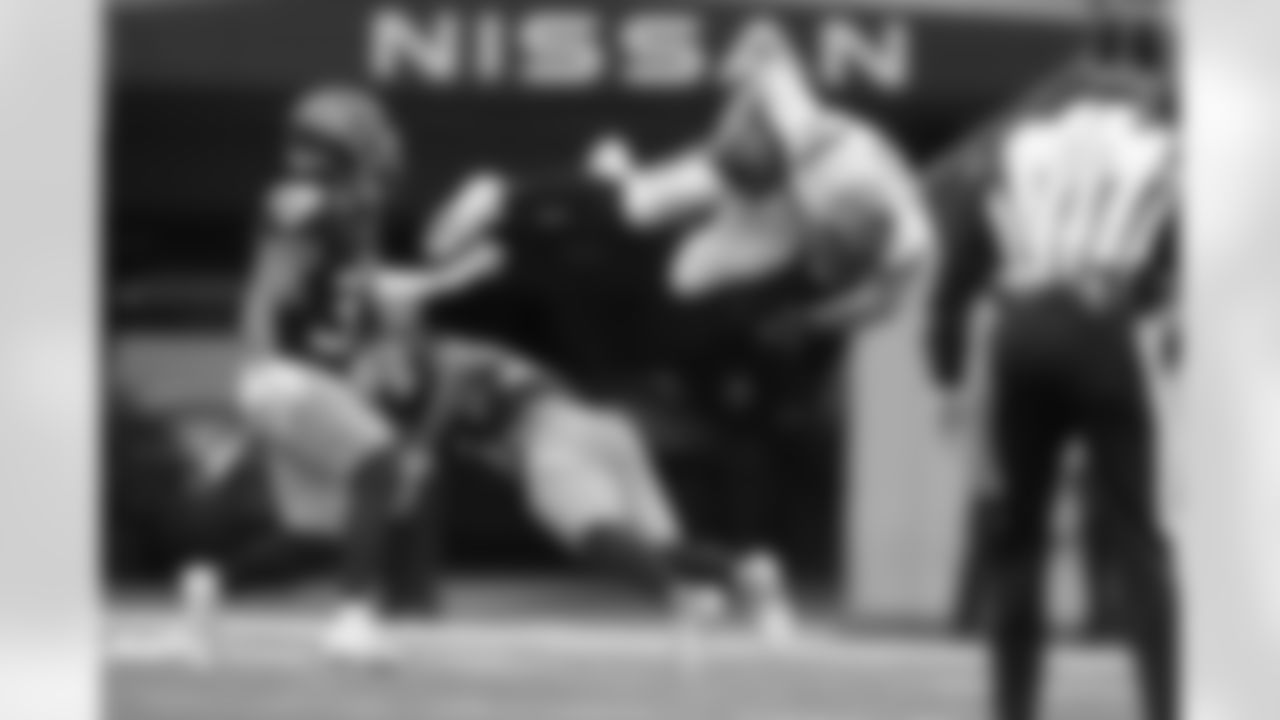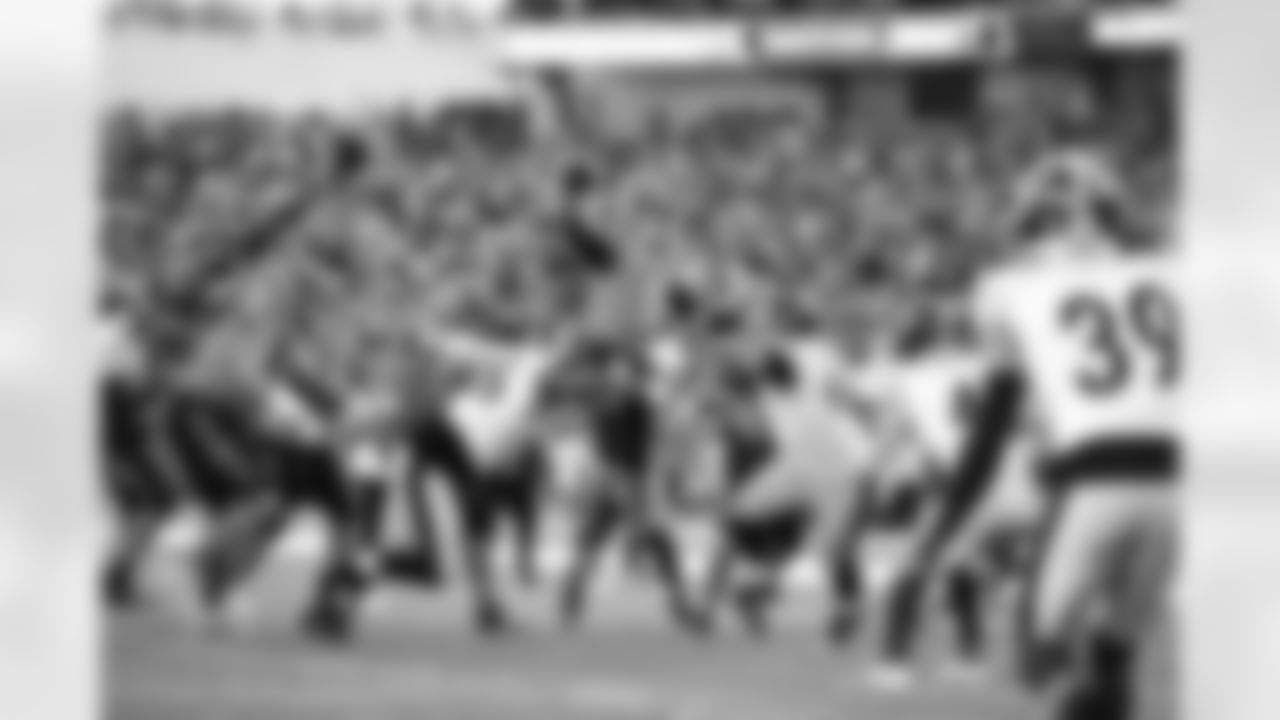The Bengals' most versatile offensive lineman of the last century has a word for their most versatile of this one.
"I take my cap off to him. I really do," says Dave Lapham, the viceroy of versatility, as he reviewed Cody Ford’s 2024 season. "To do what he did. Not only did he do it, but he was more than solid doing it."
What Ford did, according to the Elias Sports Bureau, is become the first Bengals offensive player since at least 1980 to start games at four different positions in the same season.
That cap Lapham is taking off is the old solid orange helmet with the word "Bengals," on the side. In the last season the Bengals wore those hats, 1980, Lapham maybe didn't start at four different spots, but that's the year he played all five line positions in two games.
Lapham, a right guard on Paul Brown's last team in 1975 and a left guard on the Super Bowl team of 1981, is still flashing that versatility as he heads into his 40th season as the Bengals' radio analyst.
It's from that seat during the club's most prolific offensive season ever that he saw the Bengals roll out Ford as an extra tight end against Carolina, a right tackle in the season finale in Pittsburgh, a left guard twice in December and a left tackle five times in place of his college teammate and close buddy Orlando Brown Jr.
"Was it four? Wasn't it three?" asks Ford, who smiles when he realizes that tight end counts. "It wasn't easy. Nothing is easy these days … Where ever they want me to play, I'm going to try and master that position at that time. That's where I'm always at."
Ever since Paul Brown used him everywhere after he drafted him in the third round out of Syracuse 50 years ago, people have been telling Lapham how rare it is. And he's lived it.
"There is much more different technique at tackle, particularly in pass protection, than there is at the guard position," Lapham says. "There's the physical aspect of being able to rise to the occasion, but then being able to handle the technique and the mental aspect of knowing your assignment when the calls are made … First and foremost, you have to have your nose in the playbook … You know exactly what you're supposed to do no matter where you are. You have to be able to sift through and make sure that you're doing what you're doing right guard, not left guard or right tackle."
Ford never did what he did this season. And he has bounced around, sure.
As a rookie, he started 11 games at right tackle for the 2019 Bills. The next year, he made five starts at left guard, two at right. The next year, all seven of his starts came at right guard. After the 2022 trade to Arizona, there were three starts at left guard. His only start in his first year as a Bengal in 2023 came as an extra tight end in Pittsburgh, along with a smattering of snaps at both guards.
But never nine starts in four spots in the same season.
"Knowing the playbook helps out a lot," says Ford, echoing Lapham. "Trusting technique. Knowing the technique we were coached. Just applying those things, that really eased the stress about flipping sides, flipping positions."
The odd thing, he says, is he felt the most awkward in Week 18 when he was subbing for injured right tackle Amarius Mims. Ford had played right tackle his last year at Oklahoma opposite Orlando Brown. His most starts in the league had come at right tackle with those 11 as a rookie. He's right-handed. And yet …
"Just the way I feel on the left side versus the way I feel on the right is completely different," Ford says. "Being back over there was really weird. Early in the week, I was trying to figure out my stance. Everything was just off. Maybe a lot of it had to do with just being on the left side for a consistent number of weeks and not just flipping back and forth.
"I would do drills on the left, drills on the right. Flip back and forth. Once I was filling in for Orlando, there was no reason to go to the right because I focused on the left. Then when I got promoted at left guard, there was no reason to go back to the right and do drills over there. Playing the right side was a little funky over there."
Throw in the master of funk, the Steelers' All-Pro sacker T.J. Watt, and the game they had to win could have been wrecked. But Ford fought through a chest injury and teamed with Mims, running back Khalil Herbert and a fleet of tight ends to keep Watt off the stat sheet.
Lapham admits injuries had sapped Watt of that dynamic first step, but he also knows what Ford and the Bengals did against him was extraordinary.
"He was going against pretty damn good players, and they put him in one-on-one situations a few times and didn't hesitate to do it," Lapham says. "They gave him help. Everybody gets help at some point in time. They gave him help. But when he had to line up against good players one-on-one, he more than held his own, man."
Lapham says the key is brains. Bruce Kozerski, who came the year after Lapham left in 1984, was another guy who could play all five spots and did in certain situations. He was an engineering and math guru from Holy Cross. Lapham astounded his mother when he turned down Harvard. Ford was a microscope guy, majoring in criminology at Oklahoma.
Lapham also credits Ford for being able to prepare for multiple opponents with different styles. He remembers having to get ready for every defensive lineman. Bull-rushing three techniques on the inside. Absorbing which outside rushers grab the outside shoulder or rip under your chin.
"When you're just playing that one spot, all you have to worry about is what's the best move this guy has," Lapham says. "And you have to study all the guys. Everything has to be totally coordinated. And there's a lot that goes into it. There's a lot of additional time. You have to commit to it, the preparation factor is much more intense."
When Ford made the move to left guard against the Steelers Dec. 1, Lapham thought he got a boost from being in between Brown and center Ted Karras and their combined 250 or so NFL games.
"When you're moving all around like that," Lapham says, "it's really imperative you know what the other guy is doing and I thought those all those guys did a great job with their communication. Especially on the road."
Paul Brown gave his players quizzes, and he always admired Lapham's knowledge of what everyone's job was on the line on any given play. Although Ford is 28 and heading into his seventh year in the NFL, Lapham thinks the best is yet to come because he spent this last season looking at the entire field.
"You don't have tunnel vision on one position. It opens your eyes up to everything," Lapham says." And now, it's like, when I'm at right guard and I pull, is the center blocking down? Is the fullback filling? I know the left guard has a cut-off block.
"Now you start to see the big picture. And then protections with stunts and twists and super loops and all that stuff, you just have a greater understanding of what's going on. You see the game through a wider scope, a much bigger vision. I think that's helped him. He understands why. He just doesn't understand what to do. It just gives you a much broader understanding of the entire operation."
Six years into the league and Ford says he proved much to himself.
"I'm still where I'm supposed to be at, and that's the NFL," Ford said.
And he still wants to be at Cincinnati. He heads into free agency hoping to return.
"I would love to come back. No. 1 spot on my list," Ford says. "I love what's going on here. Love the guys, love the staff, the organization. Everything about it. I would love to come back."
The first guy welcoming him back will be the big guy in the broadcast booth heading into his 50th year as a Bengal.
"A lot of value. How many guys play both guards and both tackles?" says Lapham, who is one. "I thought he had a hell of a year."
See the best shots of the offense from the Bengals 2024 season

QB Joe Burrow escapes and completes a pass against the Las Vegas Raiders in Week 9 at Paycor Stadium, Sunday, November 3, 2024.

TE Mike Gesicki makes a one-handed catch against the Philadelphia Eagles at Paycor Stadium, Sunday, October 27, 2024.

Bengals TE Erick All Jr. hurdles a defender during Cincinnati's Week 5 game against the Baltimore Ravens at Paycor Stadium, Sunday, October 6, 2024.

WR Ja'Marr Chase hauls in a 70-yard touchdown during the Bengals primetime Week 10 game against the Baltimore Ravens, Thursday, November 7, 2024.

RB Chase Brown hurdles a defender against the Denver Broncos, Saturday, December 28, 2024.

QB Joe Burrow throws a touchdown to WR Tee Higgins in the first quarter against the Browns in Week 16, Sunday, December 22, 2024.

WR Ja'Marr Chase hauls in a catch against the Browns in Week 16, Sunday, December 22, 2024.

TE Mike Gesicki flips over a defender against the Titans in Nashville, Sunday, December 15, 2024.

DE Sam Hubbard catches a touchdown against the Titans in Nashville, Sunday, December 15, 2024.

WR Ja'Marr Chase scores a first-quarter touchdown against the Cowboys in Dallas, Monday, December 9, 2024.

QB Joe Burrow throws a touchdown to Ja'Marr Chase during the Bengals Week 13 game against the Pittsburgh Steelers at Paycor Stadium, Sunday, December 1, 2024.

WR Ja'Marr Chase scores a touchdown in the fourth quarter during Week 11 against the Los Angeles Chargers at SoFi Stadium, Sunday, November 17, 2024

TE Tanner Hudson hurdles a defender during the Bengals primetime Week 10 game against the Baltimore Ravens, Thursday, November 7, 2024.

Bengals WR Andrei Iosivas hauls in a long catch during the Bengals Week 4 game against the Carolina Panthers at Bank of America Stadium, Sunday, September 29, 2024.

WR Tee Higgins catches a deep ball on the sideline in overtime against the Denver Broncos, Saturday, December 28, 2024.







